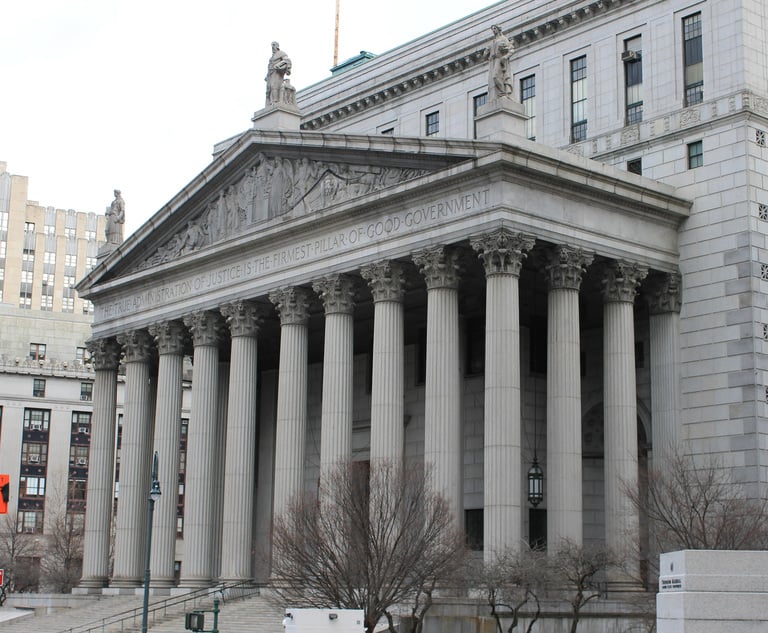Battered Brooklyn Student's Negligent Supervision Case Goes Forward
The panel's decision and the lawsuit leveled by a former student at Abraham Lincoln High School focuses on an issue that could have implications for the school system citywide: How far must school staff go to protect their students from assault?
December 21, 2017 at 06:49 PM
5 minute read
 Credit: maroke/Shutterstock.com
Credit: maroke/Shutterstock.com Pointing to potential witnesses and evidence not put forth by the defense, a state appeals court has ruled that a negligent supervision lawsuit against New York City, lodged by a student assaulted inside a Brooklyn high school, must go forward.
A unanimous Appellate Division, Second Department, panel has handed down an opinion that largely takes issue with the city for failing to produce potentially revealing information that might have swung the motion to dismiss in its favor. The panel's decision, and the lawsuit leveled by a former student at Abraham Lincoln High School, focuses on an issue that could have implications for the school system citywide: How far must school staff go to protect students from being attacked by other students, especially when at least one of the assailants was known to have beaten a fellow student before?
In K.J., an infant by his father and natural guardian, Lonnie Jefferson v. City of New York, 3840/15, the panel wrote that the city's Department of Education and Board of Education had “failed to eliminate all triable issues of fact as to whether the DOE [Department of Education] had actual or constructive notice of the fellow students' potential for causing harm, and whether, under the circumstances, the DOE provided adequate supervision at the end of the lunch period in the area where the assault occurred.”
In reaching that conclusion—and reversing Kings County Supreme Court Justice Lara Genovesi's 2016 decision granting dismissal—the panel pointed repeatedly to the lack of knowledge possessed by the city's primary witness: a school safety officer who did not see the assault occur and who was not tasked with supervising other safety personnel.
The officer, unnamed in the opinion, “testified that his job duties did not include supervision of the cafeteria during lunch, and that the deans supervise the cafeteria,” said the panel, consisting of Justices Ruth Balkin, Joseph Maltese, Betsy Barros and Francesca Connolly.
They added, “He did not know how many students attended the school, how many school safety officers were assigned to the school at the time of the incident, where school safety officers were stationed throughout the day, and how often there were violent incidents in the school hallways or the stairwells generally.”
In addition, “He did not know how many students attacked the infant plaintiff or the assailants' identities,” the justices further wrote.
Moreover, “He had a supervisor who was in charge of school safety personnel in the building, but the defendants did not proffer any evidence from that supervisor, or anyone familiar with the students involved in the assault.”
The justices also pointed out that, in support of the motion to dismiss, the Department of Education and Board of Education relied only on “the plaintiffs' testimony at hearings held pursuant to General Municipal Law Section 50-h, and deposition testimony of a school safety officer.” No other witnesses were presented.
On Dec. 1, 2014, the plaintiff, K.J., then age 14, was having lunch in a school cafeteria when someone from a table nearby threw an object at him, the panel said, recounting the teenager's testimony. In turn, K.J. went over to the table, where one of the eventual assailants challenged him to a fight.
K.J. declined. But he testified that, moments later, a group of about four students walked toward a stairwell that he was forced to use to get to class. When K.J. left the cafeteria and approached the stairwell, the four students blocked his path and then attacked him, punching and kicking K.J. for about 25 seconds, he testified.
Among the injuries the young student suffered was a fractured orbital bone near his eye, the panel wrote. K.J.'s father, a plaintiff in the suit, testified that some of the assailants were Crips gang members, the panel noted.
In leveling multiple causes of action against the education department and board, K.J. and his father included a claim for negligent supervision. Under the applicable legal standard for negligent supervision, “it must be established that school authorities had sufficiently specific knowledge or notice of the dangerous conduct which caused injury; that is, that the third-party acts could reasonably have been anticipated,” wrote the panel, quoting Mirand v. City of New York, 84 NY2d 44, 49 (1994).
“An injury caused by the impulsive, unanticipated act of a fellow student ordinarily will not give rise to a finding of negligence,” the justices added, quoting Mirand again. They also noted that the “the duty owed derives from the simple fact that a school, in assuming physical custody and control over its students, effectively takes the place of parents and guardians.”
In K.J.'s case, it was “undisputed that there were no school safety officers, school personnel or security cameras in the subject stairwell at the time of the incident,” the justices noted.
Moreover, the panel said that “defendants failed to proffer any evidence demonstrating that the DOE lacked actual or constructive notice of any prior violent behavior by any of the infant plaintiff's assailants,” and “given the witnesses' testimony regarding the disciplinary history of one of the infant plaintiff's assailants, there were triable issues of fact as to whether the DOE had specific knowledge of that student's dangerous propensities.”
In addition, the “defendants failed to proffer sufficient evidence demonstrating the general security measures at the school,” wrote the panel in the unsigned Dec. 6 opinion.
Nick Paolucci, a spokesman for the city Law Department, said in an email Thursday, “We're disappointed in the decision.” He did not comment further.
Deborah Brenner and Tahirih Sadrieh, attorneys with the Law Department, handled the appeal before the panel.
The firm of Louis C. Fiabane in Manhattan represented the plaintiffs. Fiabane could not be reached for comment.
This content has been archived. It is available through our partners, LexisNexis® and Bloomberg Law.
To view this content, please continue to their sites.
Not a Lexis Subscriber?
Subscribe Now
Not a Bloomberg Law Subscriber?
Subscribe Now
NOT FOR REPRINT
© 2025 ALM Global, LLC, All Rights Reserved. Request academic re-use from www.copyright.com. All other uses, submit a request to [email protected]. For more information visit Asset & Logo Licensing.
You Might Like
View All

Family Law Practitioners Weigh In on Court System's New Joint Divorce Program

Former NY City Hall Official Tied to Adams Corruption Probe to Plead Guilty

New Charges Expected in Sex Trafficking Case Against Broker Brothers
Trending Stories
- 1'Shame on Us': Lawyer Hits Hard After Judge's Suicide
- 2Upholding the Integrity of the Rule of Law Amid Trump 2.0
- 3Connecticut Movers: New Laterals, Expanding Teams
- 4Eliminating Judicial Exceptions: The Promise of the Patent Eligibility Restoration Act
- 5AI in Legal: Disruptive Potential and Practical Realities
Who Got The Work
J. Brugh Lower of Gibbons has entered an appearance for industrial equipment supplier Devco Corporation in a pending trademark infringement lawsuit. The suit, accusing the defendant of selling knock-off Graco products, was filed Dec. 18 in New Jersey District Court by Rivkin Radler on behalf of Graco Inc. and Graco Minnesota. The case, assigned to U.S. District Judge Zahid N. Quraishi, is 3:24-cv-11294, Graco Inc. et al v. Devco Corporation.
Who Got The Work
Rebecca Maller-Stein and Kent A. Yalowitz of Arnold & Porter Kaye Scholer have entered their appearances for Hanaco Venture Capital and its executives, Lior Prosor and David Frankel, in a pending securities lawsuit. The action, filed on Dec. 24 in New York Southern District Court by Zell, Aron & Co. on behalf of Goldeneye Advisors, accuses the defendants of negligently and fraudulently managing the plaintiff's $1 million investment. The case, assigned to U.S. District Judge Vernon S. Broderick, is 1:24-cv-09918, Goldeneye Advisors, LLC v. Hanaco Venture Capital, Ltd. et al.
Who Got The Work
Attorneys from A&O Shearman has stepped in as defense counsel for Toronto-Dominion Bank and other defendants in a pending securities class action. The suit, filed Dec. 11 in New York Southern District Court by Bleichmar Fonti & Auld, accuses the defendants of concealing the bank's 'pervasive' deficiencies in regards to its compliance with the Bank Secrecy Act and the quality of its anti-money laundering controls. The case, assigned to U.S. District Judge Arun Subramanian, is 1:24-cv-09445, Gonzalez v. The Toronto-Dominion Bank et al.
Who Got The Work
Crown Castle International, a Pennsylvania company providing shared communications infrastructure, has turned to Luke D. Wolf of Gordon Rees Scully Mansukhani to fend off a pending breach-of-contract lawsuit. The court action, filed Nov. 25 in Michigan Eastern District Court by Hooper Hathaway PC on behalf of The Town Residences LLC, accuses Crown Castle of failing to transfer approximately $30,000 in utility payments from T-Mobile in breach of a roof-top lease and assignment agreement. The case, assigned to U.S. District Judge Susan K. Declercq, is 2:24-cv-13131, The Town Residences LLC v. T-Mobile US, Inc. et al.
Who Got The Work
Wilfred P. Coronato and Daniel M. Schwartz of McCarter & English have stepped in as defense counsel to Electrolux Home Products Inc. in a pending product liability lawsuit. The court action, filed Nov. 26 in New York Eastern District Court by Poulos Lopiccolo PC and Nagel Rice LLP on behalf of David Stern, alleges that the defendant's refrigerators’ drawers and shelving repeatedly break and fall apart within months after purchase. The case, assigned to U.S. District Judge Joan M. Azrack, is 2:24-cv-08204, Stern v. Electrolux Home Products, Inc.
Featured Firms
Law Offices of Gary Martin Hays & Associates, P.C.
(470) 294-1674
Law Offices of Mark E. Salomone
(857) 444-6468
Smith & Hassler
(713) 739-1250






